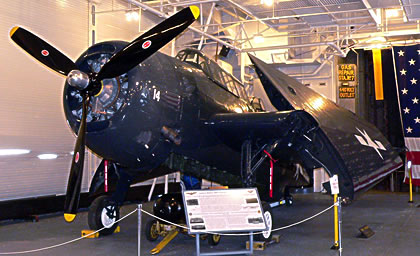Aircraft on Display
While visiting the USS Hornet Sea, Air & Space Museum our guests will have access to some of the most integral aircraft in United States Military history. These aircraft are on continuous display throughout the Museum in the Hangar Deck and on the Flight Deck.
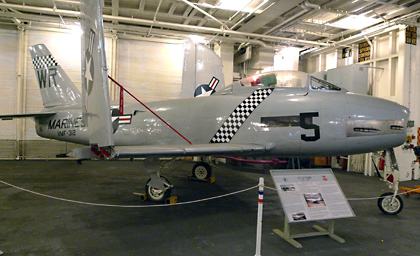
FJ-2 Fury
The first jet fighter in the world to complete an operational tour at sea.
Click Here for More Information on the FJ-2
Specifications
Wingspan: 11.31 meters (37 ft 2 in)
Span, Wings Folded: 6.89 m (22 ft 7 in)
Wing Area: 26.75 sq m (288 sq ft)
Length: 11.45 m (37 ft 7 in)
Height: 4.14 m (13 ft 7 in)
Height, Wings Folded: 4.78 m (15 ft 8 in)
Empty Weight: 5,355 kg (11,800 lbs)
Loaded Weight: 8,525 kg (18,790 lbs)
Max Speed at Altitude: 970 KPH (600 MPH / 520 KT)
Service Ceiling: 12,700 m (41,700 ft)
Range with Drop Tanks: 1,595 km (990 MI / 860 NMI)
Armament: four Colt Mk 12 20-mm cannon w/ 600 rounds
Achievements
The Fury was the first jet fighter to complete an operational tour at sea
Design Features
All Moving Tailplane: Solved shockwave air compression effects as an aircraft approaches and then exceeds the speed of sound. Speed tests by the Bell-X1 & research by the British designers of the Miles M.52 lead to this critical control breakthrough. Operationally installed on the F-86E Sabrejet in 1951 & kept secret from the USSR thus delaying its use by the Soviets until 1953 with the introduction of the MiG-19.
Swept-Back Wings & Tail: Allows for supersonic speeds by delaying the onset of shockwaves. Developed by German researchers during WWII and applied famously to the transonic American F-86 & Soviet MiG-15.
Leading-Edge Slats: aerodynamically actuated at low speed to provide additional lift during landing and improved low-speed handling. During World War II German Me-262 aircraft were fitted with a version that pushed back flush against the wing by air pressure to reduce drag, popping out on springs when the airflow decreased during slower flight. The FJ-2 uses a similar design as well as the A4 Skyhawk.
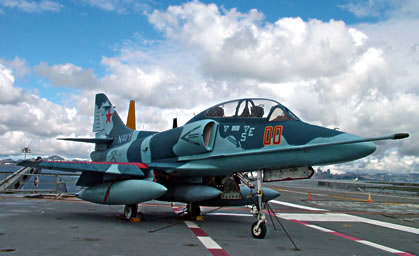
TA-4J Skyhawk
The primary role of the TA-4J was to train carrier pilots.
Click Here for More Information on the TA-4J
Specifications
Length: 42’ 7”
Wing Span: 27’ 6”
Height: 14’ 11”
Empty Weight: 10,602 lbs
Maximum Takeoff Weight: 24,500 lbs
Maximum Level Speed: 675 mph
Engine: Pratt & Whitney J52-P6A – 8,500 lbs thrust
Maximum External Load: 6,200 lbs
This aircraft is currently on loan from the National Museum of Naval Aviation.
Thank You
The USS Hornet Sea, Air & Space Museum would like to thank the following who helped make this aircraft display possible:
- United States Navy, Fleet Composite Squadron EIGHT (VC-8),
- Bay Area Tailhook Ready Room, A-4 Skyhawk Association,
- Alaska Airlines Oakland, Oakland International Airport,
- Port of Oakland, Operating Engineers, Local 3,
- Alameda County Sheriff, Alameda Police Dept., Holiday Inn.
Information
The TA-4J “Skyhawk” is a two-seat, lightweight, high-performance aircraft with a modified delta wing. It was manufactured by the Douglas Aircraft Company of Long Beach, CA, and was designed as a training aircraft capable of operating from a carrier or shore base. It is powered by a Pratt & Whitney J52 P6B and can carry a variety of external stores. The TA-4J flew for the first time on December 17, 1968. It entered service with VT-21 in mid 1969.
The primary role of the TA-4J was to train carrier pilots. A total of 226 TA-4Js were built. Many TA-4F airframes were converted to TA-4J configuration by removal of their offensive weapons systems. Several TA-4Js were used in support roles, including that of adversary aircraft. Dubbed the “Scooter” by its Navy and Marine pilots due to its legendary maneuverability and outstanding roll rate, the A-4 also became known as “Heinemann’s Hot Rod” in tribute to its designer.
Fleet Composite Squadron EIGHT (VC-8) was commissioned as Guided Missile Squadron TWO at NAS Chincoteague, Virginia, in July 1958. In January 1959, the squadron was transferred to US Naval Station Roosevelt Roads, Puerto Rico. The squadron was re-designated Utility Squadron EIGHT in 1960 and received it’s present designation in 1965.
The TA-4J Skyhawk missions include adversary air combat, towing banner targets, launching AQM and BQM drones, electronic warfare, missile profiles, raids, close air support, dissimilar air combat training, air intercept control, and radar calibration. In 1997, VC-8 obtained Level II Adversary Qualification, becoming the US Navy’s only Active Duty Adversary squadron. The squadron has been awarded the Battle “E” for Operational readiness (seven awards), the Meritorious Unit Commendation (three awards), the U.S. Coast Guard Meritorious Unit Commendation (two awards), and the Humanitarian Award (two awards). Most recently the command was named by the CNO as the overall Search and Rescue Award winner.
The VC-8 TA-4Js were retired from active service in May 2003. The active duty life of the venerable Skyhawk in U.S. Navy fleet service began in late September 1956 and spanned more than 47 years.
This aircraft was one of the last active Skyhawks in service. Her last flight was April 8th, 2003, flying from NAS Roosevelt Roads, VC-8, Puerto Rico, to Alaska Airlines maintenance facility, Oakland, CA and was subsequently towed to the USS Hornet Museum.
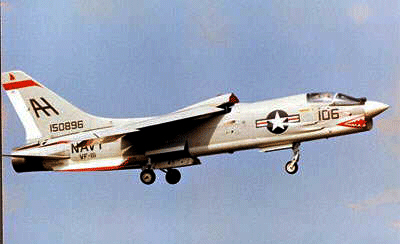
F8U-1 Crusader
The first supersonic carrier based aircraft, primarily used in Vietnam.
Adopted by
Zachary Taylor
Wyatt Morgan
Click Here for More Information on the F8U-1
Achievements
Project Bullet: 1957 – John Glenn, first American astronaut to orbit the earth, planned and piloted a flight he named “Project Bullet” from California to New York that established a new trans-continental speed record. Flying a F8U Crusader, he broke the existing record by twenty-one minutes, flying at an average speed of 723 miles per hour in the first coast-to-coast supersonic flight.
Cuban Missile Crisis: 1962 – Photo recon Crusaders (RF-8A) flew high-speed, un-armed, tree-top missions over Cuba providing the critical evidence of the Soviet Medium Range Ballistic Missile build-up. President John F. Kennedy used the recon evidence to eventually force withdrawal of the Soviet MRBM’s.
Vietnam War Combat Kills: 1966-1968
MiG-17 x Sixteen
MiG-21 x Three
Active Duty Life: 1957-1976 with the photo recon variant flying an additional 11 years.
Design Features
Operational from Essex-class Carriers (i.e., Hornet): First supersonic carrier aircraft, the huge airframe of the F-8 could still be accommodated by the smaller WWII Essex-class carriers due to the compact landing gear, variable incident tilt wing & the tremendous thrust of the Pratt & Whitney J57-P-20A afterburning turbojet engine available during launch.
7° Variable Incident Wing: The whole wing can be tilted up seven degrees during landing and take-off, increasing the angle of attack for more lift. This also provides better rear ventral clearance & visibility for the pilot as the nose isn’t pitched up as high.
Patented 1912 in Paris by Bulgarian inventor Georgi Bojino & first used in a 1939 Nazi Germany low-wing, push-pull prop design by Dornier (Do P.59) to solve similar problems & later re-adapted by Chance Vought for the F-8.
All Moving Tailplane: Solved shockwave air compression effects as an aircraft approaches and then exceeds the speed of sound. Speed tests by the Bell-X1 & research by the British designers of the Miles M.52 lead to this critical control breakthrough. Operationally installed on the F-86E Sabrejet in 1951 & kept secret from the USSR thus delaying its use by the Soviets until 1953 with the introduction of the MiG-19.
Swept-Back Wings & Tail: Allows for supersonic speeds by delaying the onset of shockwaves. Developed by German researchers during WWII and applied famously to the transonic American F-86 & Soviet MiG-15.
See the F-8 in Action
- History Channel: “Dogfights – The Last Gunfighter“
- Man, Moment, Machine: “JFK & the Crisis Crusader“
Read More
- “F-8 Crusader Units of the Vietnam War” by Peter Mersky, Osprey Combat Aircraft #7
- “MiG-17 & MiG-19 Units of the Vietnam War” by István Toperczer, Osprey Combat Aircraft #25
- “MiG-21 Units of the Vietnam War” by István Toperczer, Osprey Combat Aircraft #29
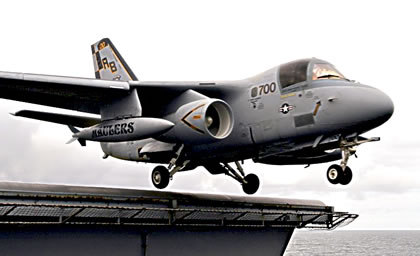
S-3B Viking
Long range anti-submarine & sea surface search aircraft.
Click Here for More Information on the S-3B
Achievements
On 1 May 2003, US President George W. Bush rode in the co-pilot seat of a Viking S-3B that landed on USS Abraham Lincoln, where he delivered his “Mission Accomplished” speech announcing the end of major combat in the 2003 invasion of Iraq. Bu.No. 160599
Active Duty Life: 1975-2009
Design Features
Long range (3,182 mi) & endurance provided by efficient GE TF-34 high-bypass turbofan engines.
Replaced piston engine S-2 Tracker in anti-submarine & sea surface search roles.
Read More
- “Lockheed S-3B Viking” by Willy Peeters, Lock On No. 23 Verlinden Publications
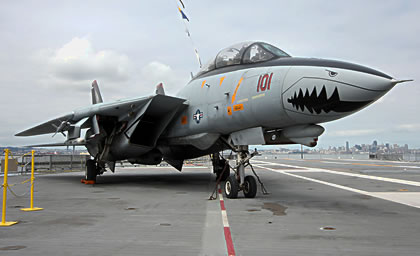
F-14A Tomcat
Supersonic, twin-engine, variable sweep wing, strike fighter.
Adopted by
William Bennett
Marvin Asato
Allen Bettendorf
Tanisha S McMahan
Mathias G Lallas
Selena Benoit
Charlotte Banks
Click Here for More Information on the F-14A
Specifications
Span (swept): 38 ft 2 in
Span (unswept): 64 ft 2 in
Length: 61 ft 11 in
Height: 16 ft 0 in
Weight (empty): 38,000 lb
Weight (Loaded): 72,000 lb
Max Fuel (internal): 16,200 lb
Armament
(6) AIM-54 Phoenix missiles
(6) AIM-7 Sparrow missiles
(4) AIM-9 Sidewinder missiles
(1) M61-A1 Vulcan 20 mm cannon
Various combinations of bombs
Propulsion: Pratt & Whitney TF 30-P-412
Maximum thrust: 14,560 lb; 25,100 lb with afterburning
Crew: 2-pilot and radar intercept officer (RIO)
Cost: $38,000,000
Bureau Number: 162689
Performance
Maximum speed**: Mach 2+
Cruising speed: 400-550 kt
Approach speed: 120 kt
Min field T.O. distance: 1,000 ft
Min field landing distance: 2,000 ft
Range: 1,600 nm
Service Ceiling: 50,000+ ft
**(Mach one = approx. 761 mph @ sea level)
History
The F-14A is the latest in a long tradition of Grumman fighters built for the U.S. Navy. It is a supersonic, twin-engine, variable sweep wing, two-place strike fighter. The Tomcat’s primary missions are air superiority, fleet air defense and precision strike against ground targets. With its twin, afterburning turbofan engines producing over 40,000 pounds of thrust, the F-14 can attain speeds greater than Mach 2.
In February 1969, the Navy selected Grumman to design this successor to the F-4 Phantom. From 1969 through 1992, a total of 710 were built: 637 for the U.S. Navy and 79 for Iran.
F-14’s were retired from the U.S. Navy’s active fleet on 22 September 2006.
Active Duty Life
The F-14 on display (BuNo 162689) was built in 1986 and served with several squadrons: VF-14, VF-41 and VF-101. During Desert Storm, as a part of VF-41, it lead the first strike against Iraq from the USS Theodore Roosevelt (CVN 71). In April 2002, 162689 was retired and delivered to the USS Hornet Museum from VF-101.
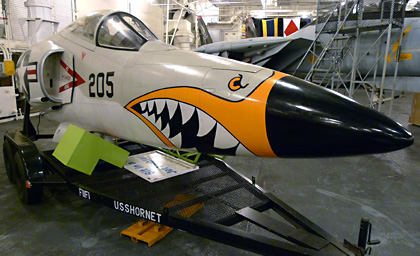
F-11 Tiger
A simple, lightweight, day interceptor to protect the fleet.
Click Here for More Information on the F-11
Specifications
Designation: F11F-1/F-11A
Manufacturer: Grumman Aircraft Corp.
Type: Day fighter
Crew: Pilot only
Power Plant: (1) 7,450 lb s.t. Wright J65-W-18
Dimensions: Span 31′ 7
Weight: 22,160 lbs
Speed: 750 mph, maximum
Range: 635 mi, tactical
History of Grumman F-11A Tiger BuNo.141821
- Accepted 03-31-58. BAR Bethpage
- VF-51 Miramar 04/58-08/58
- VF-121 Miramar 08/58-02/59
- FASRON 10 Moffett Field 05/59-12/59
- VF-111 12/59-02/61
- Storage Field Litchfield Park 03/61-11/61
- O&R BUWEPS Cherry Point 01/62-02/62
- TARON 26 Chase 02/62-11/64
BuNo. 141821
The F-11 “Tiger” was intended to be a simple, lightweight, air superiority, day interceptor to protect the fleet. It was also the last fighter produced by Grumman until its introduction of the F-14 “Tomcat”.
The F-11 was the smallest airframe possible designed around a given engine. The aircraft was so small that only the tips of the wings folded. Thin swept wings incorporating spoilers instead of ailerons coupled with an area-rule (coke-bottle fuselage) design enable the “Tiger” to achieve a top speed of over 900 mph. Tigers reached a speed of 1386.47 mph in level flight and achieved a world altitude record of 76,828 feet.
First flown in July 1954. Subsequent test trials provided for one of the most bizarre moments in aviation history when a Grumman pilot managed to “shoot himself down” with his own bullets. Firing the guns in a dive, the trajectory of the bullets allowed him to overtake them on his pullout causing aircraft damage, an engine flame-out and a crash landing.
Nearly 200 “Tigers” were produced with some going to the Blue Angel flight demonstration team. The balance were assigned to six day-fighter attack squadrons. Having been replaced by the F8U “Crusader”, the F11Fs saw only brief front-line service and were ultimately sent to Advanced Training Command and Reserve squadrons.
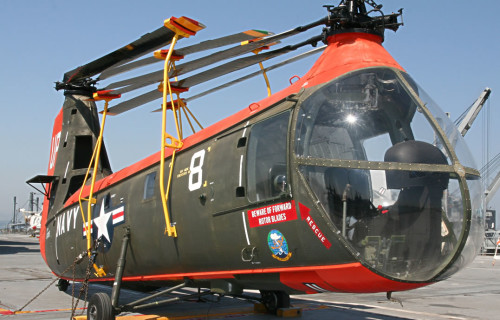
HUP-1 Retriever
A ship based utility helicopter for search and rescue.
Click Here for More Information on the HUP-1
Information
Piasecki Helicopter Corp designed the HUP family of tandem-rotor aircraft soon after World War II ended. The design goal was for a utility helicopter that could be based on U.S. Navy aircraft carriers for search and rescue, plane guard and general transport duties.
At the conclusion of the first American spaceflight to orbit the Earth, a Retriever ferried Mercury astronaut John Glenn from a destroyer to the primary recovery ship. HUPs were in service with the Navy and Marine Corps from 1949 until the early 1960s.
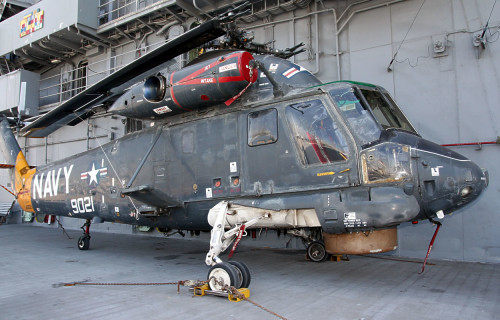
SH-2 Seasprite
Developed in the Mid-1950’s as a shipboard utility helicopter.
Click Here for More Information on the SH-2
Information
Kaman Aerospace Corp developed the Seasprite in the mid-1950s as a shipboard utility helicopter for the Navy. Its primary missions were anti-submarine warfare and anti-ship surveillance while secondary missions included search and rescue, medical evacuation, personnel transfer, surveillance and reconnaissance, post-attack damage assessment, and naval gunfire spotting. Seasprites were in service with the U.S. Navy from 1962 until 1993.
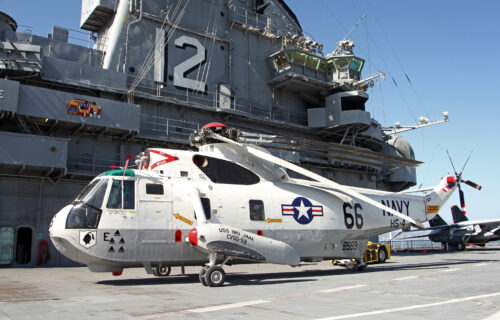
SH-3H SeaKing
All weather helicopter designed for anti-submarine warfare.
Click Here for More Information on the SH-3H
Information
Sikorsky Aircraft designed the all-weather SH-3 SeaKing family of helicopters primarily for a ship-based anti-submarine warfare mission. The Seaking could carry both SONAR detection equipment and a variety of weapons used to attack submarines. It also performed admirably in anti-ship surveillance, search and rescue, cargo and personnel transport, communications, and airborne early warning roles.
SH-3’s were the primary astronaut recovery helicopter for all Gemini and Apollo space missions. SeaKings served with the U.S. Navy from 1961 until 2006.
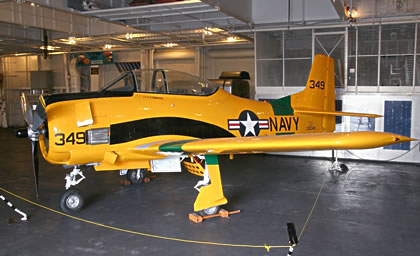
T-28B Trojan
Over 2200 of each model built and flown by twenty-one nations.
Click Here for More Information on the T-28B
Information
Our North American T-28B has been beautifully returned to its original Training Command yellow with green markings denoting it as an instrument trainer. Some of these were fitted with gun pods for aerial gunnery training. The T-28C model is the same except it has a tail hook for carrier training.
As used as the Basic Training Command aircraft, the flight syllabus consisted of: Transition, Precision, Aerobatics (TPA), Basic and Radio Instruments, Formation, Cross Country, Night, Gunnery and Carrier Qualification, totaling about 125 hours. Navy, Marine and Coast Guard student aviators flew these aircraft for more than twenty years. Bu.No. 529263
Uses other than student training were: Towing targets for fleet gunnery, instrument proficiency training for single pilot aircraft squadrons and finally for desk bound aviators when four hours per month were required for flight pay.
Over 2200 were built in all models and flew in the respective liveries of twenty-one Nations. More than three hundred are still civilian registered, with half of that amount still flying.
Compiled by Dwight Lubich, T-28 Pilot
Click Here for More Information on the TBM-3E
Specifications
Crew: Three
Length: 40 ft (12.2 m)
Height: 16 ft 5 in (5 m)
Wingspan: 54 ft (16.5 m)
Empty Weight: 10,843 lbs (4,918.4 kg)
Maximum Weight: 18,250 lbs (8278.2 kg)
Powerplant: One Wright/Cyclone R-2600-20 with 1,900 horsepower 14 cylinder, air-cooled
Maximum Range: 1,130 mi with torpedo; 1,920 mi as scout aircraft
Maximum Speed: 267 mph (at 16,000 ft)
Service Ceiling: 23,400 ft
Defensive Armament: Two wing-mounted .50 caliber Colt-Browning M2 machine guns with 335 rounds per gun; one turret-mounted .50 caliber Colt machine gun with 400 rounds; & one tail mounted .30 caliber machine gun with 500 rounds;
Offensive Armament: In bomb bay: one 22.4 in Bliss-Leavitt Mark 13 torpedo or Max. 2000 lbs of bombs or depth charges. Eight under-wing mounted 5-inch rockets.
The Avenger
This aircraft is a TBM-3 “Avenger” torpedo bomber. Purchased by the Aircraft Carrier Hornet Foundation in 1998, it has been restored by volunteers with funds provided through donations. This “Avenger” is painted in the squadron markings of VT-17, a squadron that fought from the deck of USS Hornet CV-12 during WWII.
The TBF/TBM was designed to be a replacement for the TBD Devastator. Public unveiling of the plane was scheduled for December 7, 1941. The attack on Pearl Harbor led to naming the aircraft “Avenger”. During WWII the Avenger was regarded as a rugged torpedo plane; used against surface vessels & ground targets in the Pacific. In the Atlantic the Avenger flew primarily as an anti-submarine aircraft. The aircraft was produced in many variations including versions with two wing-mounted .50 cal. guns; with special radar; with cameras for photo recon and searchlights for Anti-Submarine Warfare (ASW), utility, ECM & Carrier On Board Delivery models. After WWII, Avengers served with the Royal Navy, Royal New Zealand Air Force & French Navy. The last TBMs to be retired from active service in 1962 were flown by the Japanese Self Defense Force.
A Shared Linage
VT-17 Aboard USS Hornet 1945
VFA-25 Aboard USS Abraham Lincoln 2003
Torpedo Squadron SEVENTEEN (VT-17) was established 1 January 1943. Redesignated Attack Squadron SIX B (VA-6B) 15 November 1946.
Redesignated Attack Squadron SIXTY-FIVE (VA-65) 27 July 1948. Redesignated Attack Squadron TWENTY-FIVE (VA-25) July 1959.
Redesignated Strike Fighter Squadron TWENTY FIVE (VFA-25) July 1983 (first squadron to be assigned the VFA designation).
7 Apr. 1945: VT-17 based on U.S.S. Hornet CV-12, along with other units from task force 58.1, attacked a Japanese naval force composed of the super-battleship Yamato and her escorts. Facing a heavy onslought of fire, VT-17 aircraft scored the first torpedo hits on the Yamato & sunk one of her destroyer escorts. For their actions in this battle the following squadron personnel were awarded the Navy Cross: Lieutenants T. C. Durkin and S. G. Sullivan; Lt(jg) J. F. Monaghan & Ensign W. F. Nickel. Lieutenant H. E. Clark; Lt(jg) T. J. Coghlan and Ensign R. S. Hanlon were awarded the Silver Star for their actions. All of VT-17’s aircraft did not return, Ensign Leo O’Brien; his gunner, Jacob E. Ricketson; and James L. Opheim, were missing in action.
Operation Iraqi Freedom 2003: VFA-25, based on U.S.S. Abraham Lincoln CVN-72, was part of the longest U.S.Naval deployment in 30 years. With the first strike against targets in Baghdad, VFA-25 began flying 20 combat sorties daily delivering a total of 300,000 lbs. of ordinance which resulted in the destruction of armored divisions, military airfields, facilities and command & control infrastructure.
The “Fist of the Fleet” squadron insignia and nickname are known around the world. A black fist clenching a red lightning bolt on a field of yellow with three stars representing a war in which “Fist” aircraft have flown –in World War II VT-17 TBM Avengers, in Korea VA-25 AD Skyraiders and in Vietnam VA-25 AD Skyraiders & A-7 Corsair II. With Operation Iraqi Freedom the squadron now has a fourth star.
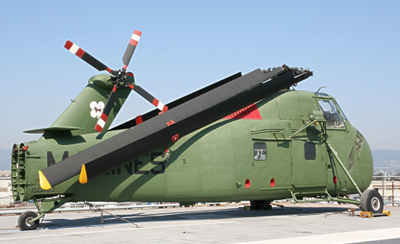
UH-34D Seahorse
Vietnam era personnel transport and combat assault helicopter.
Click Here for More Information on the UH-34D
Sikorsky Aircraft created the H-34 family of medium-lift helicopters to serve multiple roles with different branches of the military. The primary missions of the UH-34D variant with the U.S. Marine Corps included personnel transport (12 to 16 troops), combat assault, search and rescue, medical evacuation, and cargo transport. They also gained national fame as the recovery helicopter for the early Mercury space flights.
Seahorses became an icon of the Vietnam ground war and were in service with the Marines from 1957 until 1974. Hornet’s exhibit, Bu.No. 150553, entered service in August 1963. It served in Vietnam from late 1965 through 1967 and was damaged by hostile fire during seven of its combat missions. The aircraft was a donation from the Pima Air Museum in 2003 and has been restored to its USMC HMM-363 squadron appearance.
US-2B Tracker
The first carrier-based anti-submarine aircraft combining detection and attack roles.
Adopted by
Nolan Carillo
CDR Paul Edwards USNR Ret.
Click Here for More Information on the US-2B
Specifications
Crew(S-2A): 4 man crew (pilot, co-pilot & two ASW operators)
Length: S-2A,B,C 42 ft 0 in (S-2D,E 43 ft 6 in)
Height: S-2A,B,C 16 ft 4 in (S-2D,E 16 ft 7 in)
Wing Span: S-2A,B,C 69 ft 8 in (S-2D,E 72 ft 7 in)
Engines: 2 Wright R-1820-82WA Cyclone
Horsepower at takeoff: 1,525 bhp
Max speed (Sea Level): S-2A,B,C 229 kts. (S-2D,E 210 kts.)
Cruising Speed: 130 kts.
Service Ceiling: S-2A,B,C 22,000 ft (S-2D,E 19,000 ft)
Combat Range: S-2A,B,C 841 nm. (S-2D,E 1000 nm.)
Weapons: Nuclear depth charges, conventional depth bombs, five inch rockets, Zuni rockets and homing torpedoes
Combat Endurance: S-2A,B,C 6.5 hrs.; S-2D,E 7.7 hrs.
BuNo. 136691
The twin-engine S-2A (S2F-1) Tracker, introduced in 1954, was the first carrier-based anti-submarine aircraft specifically designed to combine the detection and attack roles in a single aircraft. As early models of the S-2 were replaced some were modified to utility versions such as the US-2B. The S-2 airframe also served as the basis for the carrier based C-1 Trader transport and E-1B Tracer early-warning aircraft. Converted S-2 Trackers continue to fly today as fire-fighting aircraft with the California Department of Forestry.The anti-submarine varient of the Tracker was equipped with a wide array of electronics and sensors capable of detection, localization, and classification of submarine contacts. The S-2A was fitted with a wing-mounted 85 million candle power searchlight, retractable magnetic anomaly detector, electronic counter measures equipment and 20 sonobuoy dispenser tubes in the rear of the engine nacelles. The S-2Bs were later converted from S-2As by adding Jezebel acoustic echo ranging system. The S-2C features a larger weapons bay to facilitate the use of a bigger ASW torpedo. They were replaced in the fleet by the S-2D and S-2E, distinguished from their predecessors by an increased wingspan and a lengthened fuselage. Greater internal fuel capacity increased the range of the later models.
“Stoofs” (for S-two-F) were one of the strongest and most versatile Navy aircraft ever built. More than a thousand have been produced for the U.S., Argentina, Australia, Brazil, Canada, Italy, Japan, the Netherlands, nationalist China, Thailand, and Uruguay.
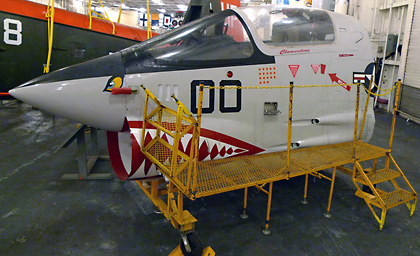
F-8 Crusader
The United States Navy’s first supersonic jet fighter.
Click Here for More Information on the F-8
Specifications
Length: 54 ft 3 in
Wingspan (folded): 22 ft 6 in
Wingspan (spread): 35 ft 8 in
Height: 15 ft 9 in
Engine: A Pratt and Whitney J-57-P-16
Thrust: 13,000 lbs in military, 17,500 lbs in afterburner
Empty Weight: 17,550 lbs
Armament: four Colt-Browning 20mm aircraft cannons, four Sidewinder air-to-air missiles, rockets & with under-wing pylons mounted, the F-8 could carry up to 4,000 lbs of bombs.
History
VF-103 (1960-1964)
VF-84 (1964)
VF-174 (1964-1965)
VU/VC-4 (1965-1968)
VF-13 (1968)
NPRO Dallas (1968)
NAS NORIS (1970)
VC-5 (1970)
VFP-63 (1970)
VF-202 (1970)
MARTD (1971-1973)
DMAFB (1973-disposal
Information
The F-8 Crusader was the United States Navy’s first supersonic jet fighter. It was also the Navy’s last dedicated, gun-armed fighter jet. This distinction leads many to call the Crusader, “Last of the Gunfighters”. The F-8s superior combat exchange ratio (18 enemy planes shot down vs. 3 lost) against Vietnamese MiGs lead to a Vought representative to call the F-8E the “Mig Master”, the name stuck. A direct descendant of the classic Vought F4U Corsair, the Crusader did the unheard of when the prototype went supersonic on its’ maiden flight
This cockpit section was removed from the fuselage of a Chance Vought F-8K Crusader. The F-8K was originally manufactured as an F-8C. Both the Navy and Marine Corps flew the F-8C in combat during the Vietnam War. During these combat deployments the F-8C was credited with six kills (5 MiG-17s and one MiG-21). In 1968, Vought began to modernize the F-8C into the F-8K. Upgrades included under-wing mounts for carrying ordinance and improvements to the cockpit. This cockpit section is painted in the colors of the “Sun-Downers” of VF-111. Aboard Hornet in WWII as VF-11, the “Sun-Downers” is one of the most famous names in naval aviation. During the Vietnam war VF-111 served on 8 deployments (1963-1970). On September 9, 1968 a “Sun-Downers” F-8C flown by Lt. Tony Nargi shot down the last official F-8 MiG kill of the Vietnam War. The Crusader finished service with the United States Navy in 1987, the French Navy retired their Crusaders December 1999, ending 44 years of F-8 Crusaders in naval aviation.
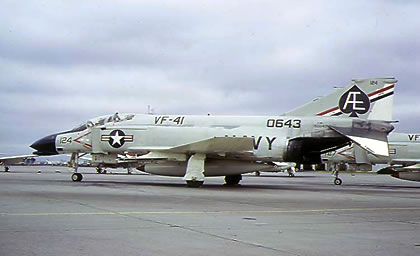
F-4J Phantom II
In 1961, an F-4 set the world speed record at 1,604 mph.
Adopted by
Ryan Barber
Tanisha S McMahan
Click Here for More Information on the F-4J
Achievements
The F-4 established 16 speed, altitude and time-to-climb records. In 1959, its prototype set the world altitude record at 98,556 feet. In 1961, an F-4 set the world speed record at 1,604 mph on a 15-mile circuit. By the end of production in 1985, McDonnell had built 5,068 Phantom II’s. Bu.No. 153879
Active Duty Life: 1960 to 1996
Design Features
- Armed with missiles only until the F-4C version installed an external 20mm gun pod. The F-4E got an internally mounted Vulcan M61A 20mm canon.
- Boundary layer air control system on leading edge flaps
- Could carry an external bomb load of no less than 22,500 lb. – greater than that of a Boeing B-29 Superfortress.
Read More
- “US Navy F-4 Phantom II MiG Killers 1965-70” by Peter Davies, Osprey Combat Aircraft #26
- “US Navy F-4 Phantom II MiG Killers 1972-73” by Peter Davies, Osprey Combat Aircraft #30
- “F-4 Phantom II vs MiG-21” by Peter Davies, Osprey Publishing
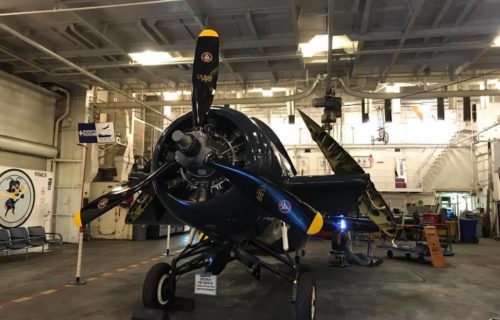
FM-2 WILDCAT
The Wildcat’s achievements in combat were outstanding. It had the honor of being the only Navy fighter to serve throughout America’s entire time in the war, from the attack on Pearl Harbor to VJ-Day.
Adopted by
Daniel Ibarria


